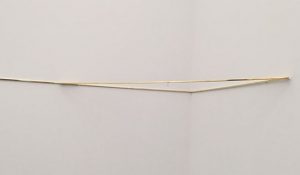Appearances are deceiving would be a good warning when walking into “Smoke, Nearby,” the gallery at Museum of Contemporary Art Chicago currently exhibiting works of Mexico City-based sculptor Tania Peréz Cordova.

Her works are not meant to be looked at in passing. They require more than a glance at something mounted piece before going on to a work displayed on the floor.
As explained on a board near a sculpture with an earring the artist explains: “A woman s missing her left earring. It is suspended on a brass ribbon in the gallery. Until it is reunited with its mate the sculpture exists in both places simultaneously.”
Thus her pieces are experiential. Or as Cordova said when interviewed before the exhibit opened, “They are stories and possibilities.”
Visitors see a SIM card embedded in porcelain, actually two such works in this show. One is “Voice,” the other “Call Forwarding.”
What are the possibilities? They could be a statement about a culture dependent on cell phones. But Cordova’s sculptures don’t make obvious statements.

A board next to “Voice,” says “Phone calls to two numbers are interrupted. The calls of anyone who tries to reach these anonymous cell phone holders will be redirected to their new SIM cards, rendering communication almost visible. The phone carriers are unidentified.”
The Sim card sculptures and a work that has a piano key but is not in the show are part of Cordova’s new series of changing or disruptive circumstances regarding objects’ functions. The changed situation may lead to other possibilities and become interesting stories.
“Taking a piano key or SIM card can change a situation. I borrowed the SIM card and we worked with the phone company to forward calls to a temporary number. The real SIM card is in the sculpture. The situation was organized to make a temporary disturbance in an object of communication,” said Cordova.
“With the piano key, I said choose a piano key that would disturb one of your songs. The disruption of the song is now creating other stories,” she said. Cordova added “I liked the idea of an object as part of a story and that sculptures have stories.”
Even her title “Smoke, Nearby” is supposed to get people thinking. “Understanding what new possibilities there are is also looking at how a space relates to surroundings,” she said.
Standing by a section of glass on the floor in a far corner, I learned it was taken from the ceiling above so thought there should be an arrow pointing up. That way people would look up and see it came from there.
But MCA Associate Curator José Esparza Chong Cuy who organized the show disagreed. “Tania wants you to use your imagination. People are used to being told what things are. Some people are uncomfortable when not told what something means. They want certainty,” he said
“Tania wants you to think about what it is,” Esparza said. “The truth of Tania’s work is freeing you to use your imagination. Not being told allows us be more experimential.”
Or as Cordova said, “Make your own stories.”
Details: “Tania Pérez Córdova: Smoke, Nearby” is at the Museum of Contemporary Art Chicago, 220 E. Chicago Ave., April 15 through Aug 20, 2017. For admission and more information call (312) 280-2660 or visit MCA.
